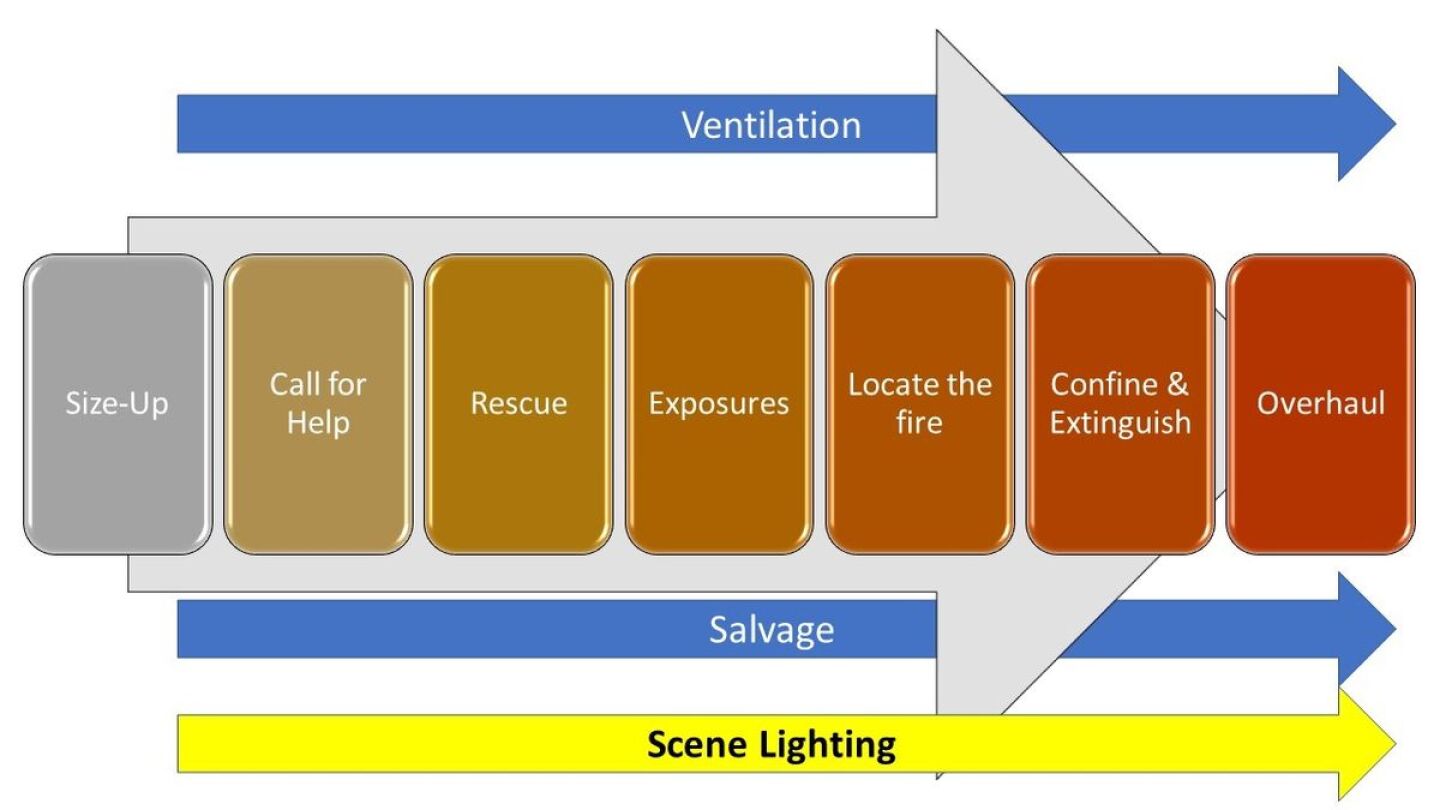The inability to clearly see the incident scene and properly evaluate that scene for potential risks must become one of the primary risk factors that we address early in the incident lifecycle rather than later.
If it’s not already a part of your incident management strategies, lighting up the incident scene should be the third “concurrent incident management strategy” taking its rightful place alongside salvage and ventilation (See Figure 1). If we can’t see the risk, we can’t address the risk.
For the fire officer tasked with illuminating the incident scene, the necessary equipment includes – but is certainly not limited to – portable lights, support stands for those lights, electricity supplies, power cords and junction blocks.
Electricity supplies, power cords and junction blocks? This is 2019, not 1989 and the innovations in in portable lighting have far surpassed the days when lighting up the scene meant running an electrical cord from a generator mounted on the apparatus to power one Circle “D” light.
The manufacturers of scene lighting equipment have responded to the requirements of today’s emergency responders with products that go beyond single halogen lights using power cords running back to the truck or engine. These products are light-weight, portable, and designed for both quick deployments anywhere on the emergency scene and extended operating times.
Two of the significant advancements have been the introduction of LED lights and lithium-ion batteries. The former provides vastly greater illumination power from smaller lighting packages; and the latter stretches out the amount of run time enabling emergency responders to place it and be done with it.
The latest scene lighting innovation comes from Streamlight, a leading manufacturer of lighting products for fire and emergency services since 1973. The Streamlight Portable Scene Light II gives firefighters and other emergency responders the portability and illumination power to light up any scene or task anywhere.
With its high-impact thermoplastic housing, mounted in an alloy steel frame, the Scene Light II is built to stand up to the harsh realities of any emergency scene. The Scene Light II carries an IPX7 rating, meaning it can take a 30-minute submersion in one meter of water and come up operating.

Table 1. A quick physics refresher is probably helpful. Wattage is the measure of the rate of energy conversion or transfer, that is, the power required to operate a fixture or appliance. Lumen is the measure of the total amount of visible light emitted by a source. Source: https://www.streamlight.com/en/products/detail/index/portable-scene-light-ii
The Scene Light II is also compact at just 1.22 cubic feet (0.04 cubic meters) and 15.38 pounds (6.1 kilograms). The small size and weight, when combined with its hooked feet, make the Scene Light II is practical for hanging over doors, guard rails, and fences and anywhere else you need good lighting to get the job done.
The Scene Light II has a digital display on the back of the lighting head that shows intensity level and current run time, taking the guess work out of how long the lights will stay on.
The Scene Light II comes with two 10.89 volt, 5.2 amp hour, 56.63 watt hour lithium-ion battery packs with an onboard safety control circuit. It comes with an AC/DC charge cord that can be used to provide electricity to the unit for continuous 100 percent illumination intensity. The same cord is used for charging the lithium-ion batteries with a typical of six hours to achieve a full charge. And those batteries packs are capable of being recharged up to 800 times.
Need more light for a job? You can stack up to three Scene Light II units to create a rugged and stable light tower anywhere on the emergency scene.
The inability to clearly see the incident scene, and properly evaluate that scene for potential risks, should be one of the primary risks that an incident commander addresses early in the incident lifecycle rather than later. The Scene Light II gives an incident commander just such a tool in a lightweight yet powerful illumination package.
What you can’t see can hurt you.

Figure 1. Concurrent strategies for incident management (e.g., ventilation and overhaul) are implemented by the Incident Commander wherever they are necessary to support the overall incident objectives. Scene lighting must become the 3rd concurrent incident strategy. Original graphic created by Robert Avsec.














